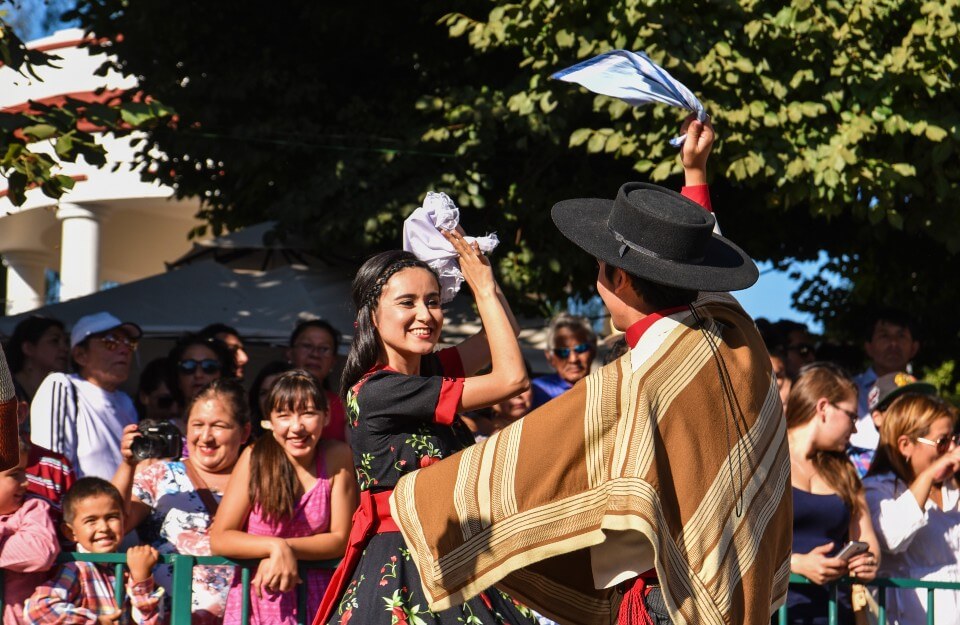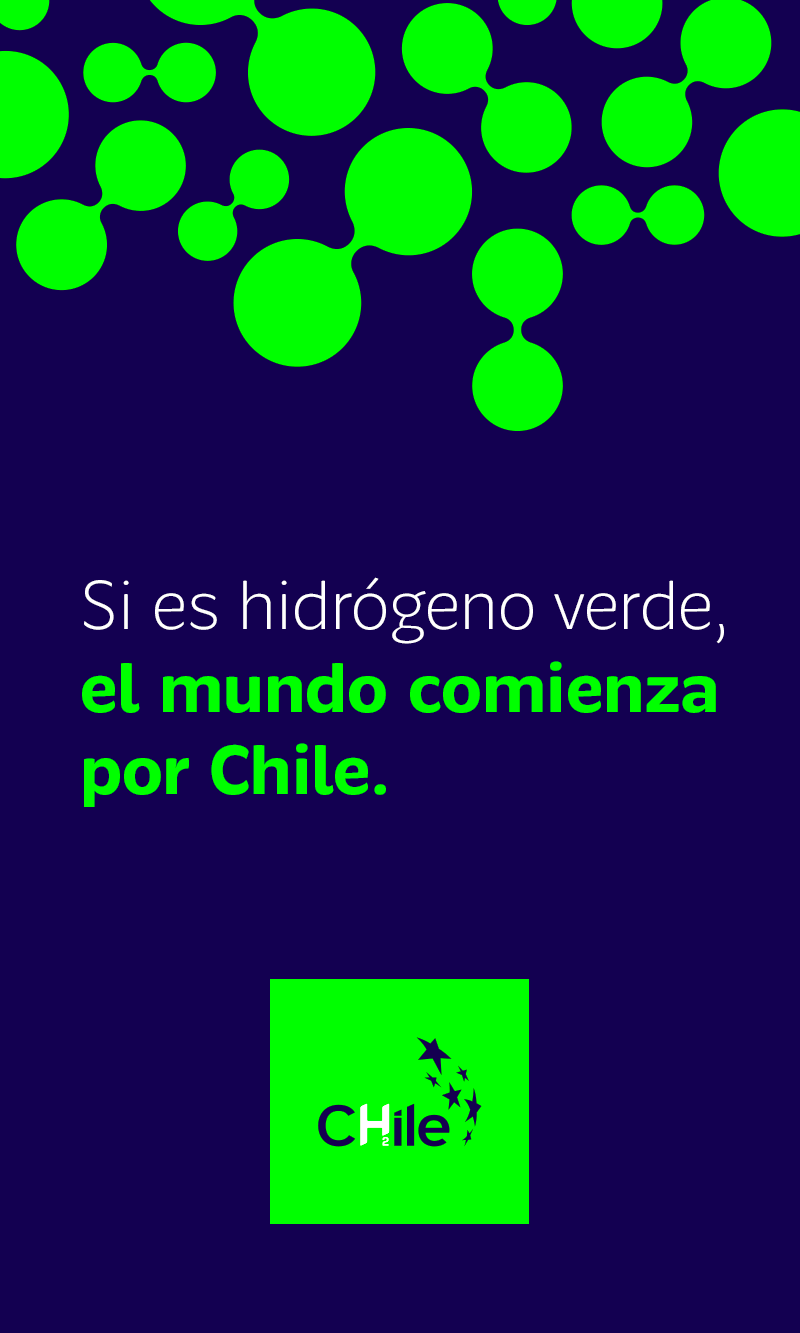
In northern Chile’s Fiesta de la Tirana, the sunrays shine on the colorful costumes, instruments and masks of dancers performing the carnivalesque dance of diablada.
Easter Island’s Tapati Festival is playful and magical, while at the Cuasimodo festival in central Chile a priest brings the Holy Communion to the sick, escorted by bandana-wearing horsemen.
On the island of Chiloé, people hold mingas, gathering in working groupa to celebrate a neighbor building a house or moving in, while elsewhere in the country, mingas are held for harvests of corn, cherries and grape cider.
And then there are the Fiestas Patrias, Chile’s annual national celebration of the independence from the Spanish crown. (September 18th). The date is commemorated to the rhythm of the national dance, the cueca, and celebrated with red wine, grape cider and savory salt pies called empanadas. Hundreds of thousands of people throughout Chile take part, and tourists visit from all over the world.
Directory of Popular Festivals
Fiesta Tapati on Easter Island (Rapa Nui)
On the mystical land of Easter Island, the February Fiesta Tapati sees painted bodies become art. A queen is chosen for the festival among the youngsters, who compete for their honor in swimming and canoeing competitions using small boats and rafts made of totora reeds. The teams prepare traditional costumes, songs and dances, and share the stories of myths and legends through oral narrations. Body painting, called Takona, is the festival’s chief characteristic, where the islanders paint their bodies with symbols of their mythic origins using natural pigments. Physical skill is also put to the test in the Haka Pei competition, in which the most daring young men hurl themselves at great speed down a mountain, tobogganing over banana tree trunks.
El Carnavalón
Also in February is the Carnavalón festival, held in the northern regions of San Miguel de Azapa, Putre and Socoroma. The carnival, which attracts thousands of people each year from the Chilean high plateau or altiplano, is a traditional Hispanic-Amerindian festival, celebrated 40 days before Lent. It is held to symbolically resurrect Ño Carnavalón, an ancient symbol of joy, fertility and fortune, whose presence is a sign that there will be happiness throughout the year. It is also a greeting to Pachamama, Mother Earth, and to Tata Inti, Father Sun, accompanied with music, dancing, and local fruits, in a promise of abundance.
La Semana Valdiviana (Valdivian Week)
There are more festivals in February. In southern Chile, the region of lakes and thousand-year-old forests, the residents of Valdivia celebrate the founding of their city on February 9, 1552 in the festival of La Semana Valdiviana. “On the Calle-Calle River the moon is dancing,” goes a local song. And each year on February 9, scores of vessels make the river come to life, captivating Valdivians and visitors from all over Chile and abroad. The garlanded ships compete for the prize of most glamorous vessel of all, and are the perfect setting for crowning the Queen of All Rivers. A fireworks display closes the festival, while along the riverbank people enjoy street performances, dining and drinking beer, the latter being a reminder of the cultural influence of the German immigrants who began to arrive in the region by the 1800s.
Grape Harvest Festival
The prestige of Chilean wine is celebrated in a special way in the central zone. Preparations begin with the arrival of summer, and the festivities culminate during the final weeks of March. The Grape Harvest Festival of the city of Curicó is probably the most impressive of all. A religious ceremony blesses the first batch of pulped grapes, followed by a parade. The Grape Harvest also chooses a Queen, who is weighed on a balance against bottles of wine while a contest is held between grape stompers. Each competing team stomps 20 kg of grapes for ten minutes, until the fruit is converted into juice. Applause and shouts of encouragement follow the stompers’ energetic progress as they compete to crush all the grapes and produce the largest quantity of juice they can.
Indigenous New Year
The indigenous peoples of Chile – the Aymara, Quechua, Rapa Nui and Mapuche nations – follow their own ancestral calendar. For them the New Year begins with the winter solstice on the night of June 24. The harvest has ended and the earth must rest, prepare herself for the sowing of crops, and renew her fertility. It is a new cycle of life, and the indigenous cultures express their gratitude to Nature. The New Year festival of the Mapuche is the best known of all. It is called We Tripantu, meaning “the sun’s new turn” or “the return of the sun.” It is celebrated in the rural regions of southern Chile, right in the main square of the city of Temuco, and in Santiago, on Cerro Santa Lucía (Huelén).
Fiesta de San Pedro
April is the month of the Chile + Cultura festival, organized nationwide by the National Council of Culture and the Arts. It congregates the work by Chilean artists and artisans throughout the country, bringing culture to the public and creating spaces for the artists to exhibit their work. Musicians, poets, painters, filmmakers, actors and dancers take part, displaying their work to the massive audiences that bring the festival to life.
Fiesta de La Tirana
La Tirana is a small town in the northern Tarapaca Region, near the city of Iquique. But its annual festival, Fiesta de la Tirana, has acquired an importance that spreads far beyond the region. It has become Chile’s most celebrated festival, visited by both local pilgrims and tourists. Each year, on June 12 to 17, dancers and musicians enact the diablada, the ‘dance of the devils’, a carnavalesque dance for exorcising demons. The dance troupe, wearing fearsome costumes and masks, move to the rhythm of drums and flutes, with the leader of the troupe setting the pace with the most fierced devil costume. The festival demonstrates a synthesis between local indigenous religions and Catholicism, also paying tribute to the Virgen del Carmen, or ‘Our Lady of Mount Carmel’. Descendants of the Atacameño, Kunza, Aymara and other indigenous peoples arrive at the Virgin’s sanctuary in processions, making promises in exchange for blessings. Masses are held at the church while in the surrounding area there are stalls with handicrafts and food, and dancing throughout the day.
Winter Carnivals in the South
The winter cold of the far south is brightened by the warmth of its festivals and carnivals. In July, the Fiesta de la Nieve or Snow Festival is held in Puerto Williams, the southernmost city in the world. Locals and tourists all take part. In the same month, in Punta Arenas, is the Winter Carnival, the region’s most important festival. Parades and street bands circulate in the center of the city, local girls compete to win the scepter of the Carnival Queen, and fireworks light up the night sky along the Strait of Magellan.
Fiestas Patrias – National Holidays
On the 18th and 19th of September, Chile’s National Holidays’ massive celebrations take place. The coming of Spring is anticipated with open-air ramadas, shelters with roofs made of tree branches, and fondas, refreshment stands offering typical dishes, meat or cheese empanadas, cider and red wine. Under the shelter of the ramadas people dance Cueca, the national dance of Chile. It is found with small local variations throughout Chile, and consists of pairs of dancers waving handkerchiefs in the air to depict couples, courting and flirting. The people commemorate the First Government Assembly, which marked the beginning of Chile’s independence on September 18th, 1810, and military triumphs are celebrated with a parade, presided over by the President, in Santiago’s Parque O’Higgins. The Chilean flag is displayed on houses and apartments and children fly kites and play with marbles and yo-yos. They have hopscotch competitions and greased pole climbing contests. There are horse races, Chilean style – bareback, the rider holding onto the horse’s mane – while rodeos are held in traditional rings.
Fiesta de La Virgen de Andacollo
The Festival of the Virgen of Andacollo, in the northern town of Andacollo, is a popular religious festival celebrating copper, Chile’s greatest natural resource. Andacollo was a settlement of Molle people, who are related to the Incas and developed great agriculture techniques and exploited the copper resources. In their native language, Quechua, ‘anda’ means copper, and ‘coya’ means monarch, and the Virgen of Andacollo is thus known as the Queen of Copper. The festival, held each year on 24th – 26th December, is one of the most widely-attended religious festivals in Chile, with Chinese dances and pledges to the Virgin. Chilean and foreign tourists are habitual visitors and participants.
Christmas
Like most Christians around the world, Chileans commemorate the birth of Jesus Christ on December 25. On Christmas Eve, families gather together to eat fruit cake and drink cola de mono, a traditional drink prepared with spirits, milk, sugar, coffee and cinnamon. This holiday is especially dedicated to children, who receive gifts from Santa Claus, known in Chile as “El Viejito Pascuero”. Presents are placed under a Christmas tree hung with lights and decorated with cotton wool ‘snow’, and the children open their gifts at midnight. Under the tree is a manger, with Baby Jesus being worshipped by the Three Kings. Traditionally, people sing Christmas carols from the farming community, and attend Church services held on Christmas Day.
New Year
New Year is welcomed in cities throughout Chile with spectacular fireworks displays at midnight on December 31. The most impressive are in the port city of Valparaiso, where thousands of people seek out the best vantage points on hillside terraces overlooking the sea. People usher in the new year by hugging, toasting with champagne and exchanging wishes for prosperity. Many have their own rituals for New Year: some people eat lentil dishes; some write down everything that was bad about the past year, and then burn the paper symbolically; some write down all their wishes for the year to come, and then hide the piece of paper away. There are those who go out walking with luggage, so they will travel during the year; and there are those who wear ‘lucky’ items, such as yellow underwear or borrowed or new clothes.






